Have your employees ever asked you about the steps involved in requesting time off? Do your team members bombard you with questions before your team-building sessions?
How many times have you explained the educational budget parameters to new hires?
These are all questions that could be answered in an internal knowledge base.
A collection of articles regarding your company’s internal processes, an internal knowledge base is a terrific medium to circulate information amongst your employees.
Instead of second-guessing themselves, they can easily find the answer.
In this article, we’ll share tips on creating an effective internal knowledge base that your employees will be able to use to find all the answers they need.
Develop a Structure That Works for Your Team
The purpose of an internal knowledge base is to give your team members a centralized, reliable repository of information.
With this resource, they should have all the necessary information to perform their job well.
However, all this data isn’t worth much if your team members can’t navigate it.
Unfortunately, this is a pervasive issue, as a recent survey uncovered the following findings:
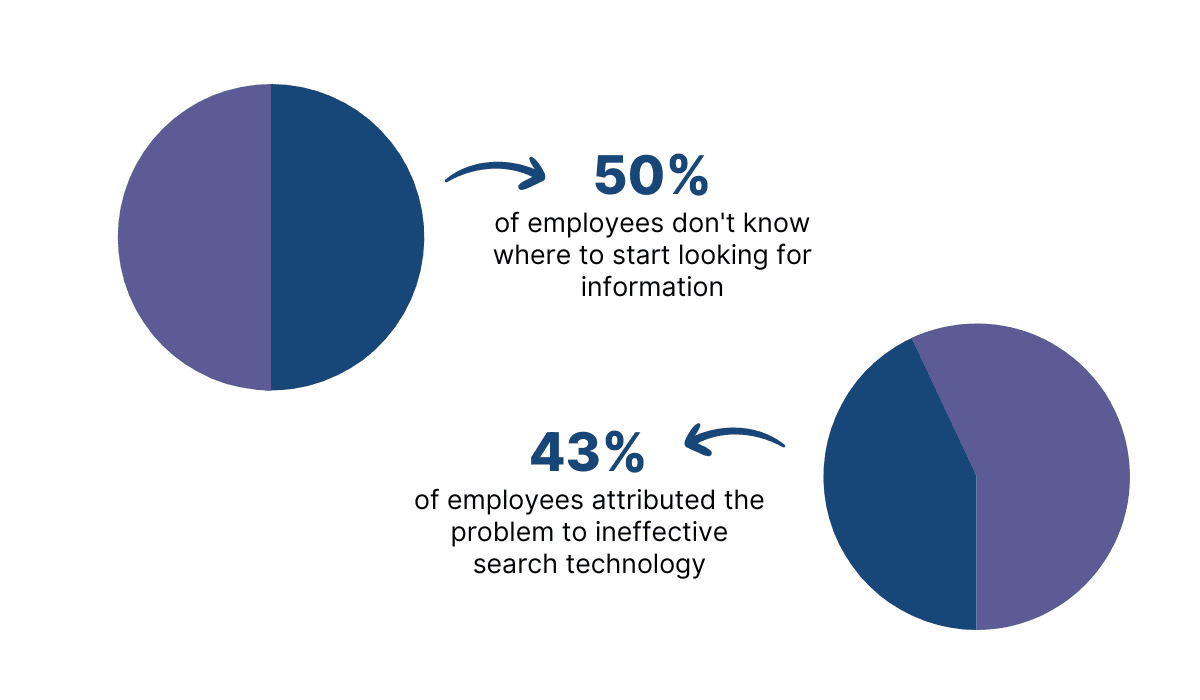
Illustration: Archbee / Source: Coveo
Employees clearly need help finding information, with most citing sub-par search technologies as the chief culprit.
Consequently, ensure to equip your knowledge base with a robust search engine.
That way, even if the structure of your knowledge base isn’t completely developed, you still provide an easy way for employees to locate the materials they need.
As to the actual architecture, Slite’s internal knowledge base can serve as inspiration:
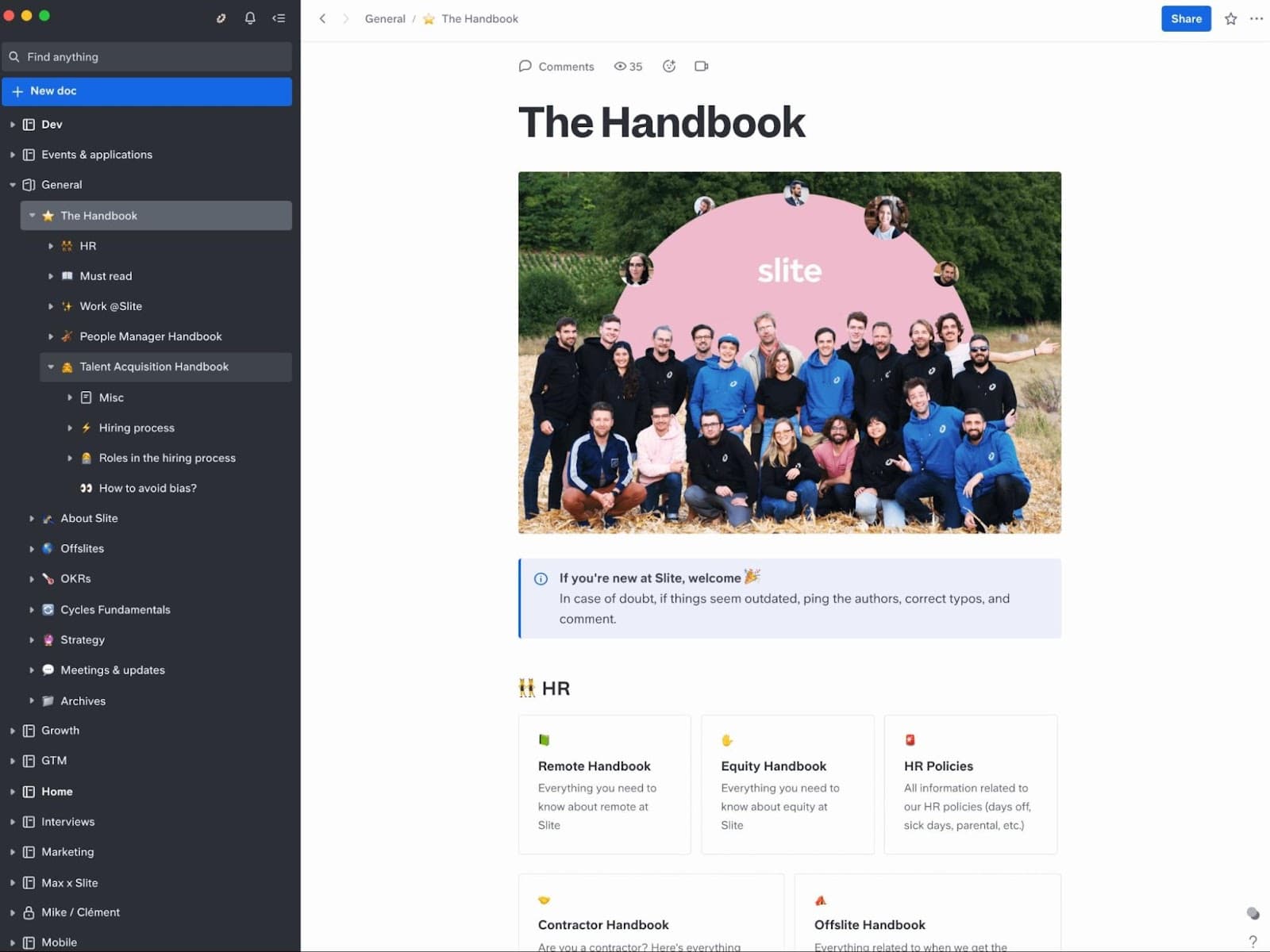
Source: Slite
The table of contents on the left-hand side covers the entire content of the knowledge base.
As such, readers will always have an accessible knowledge base overview and be able to browse other sections at a glance.
Furthermore, such a comprehensive table of contents makes for easy navigation. Users can jump between sections within the knowledge base with just a few clicks.
In addition to this, each section is broken down into various subsections.
This screenshot segments the HR Handbook into a remote handbook, contractor handbook, equity handbook, and more.
With this top-down structure, readers begin with general information and can then pinpoint the precise categories relevant to them.
The funnel-like workflow, from broad to detailed, enables your employees to quickly find the information they need.
For other structuring ideas, look at the visual below:
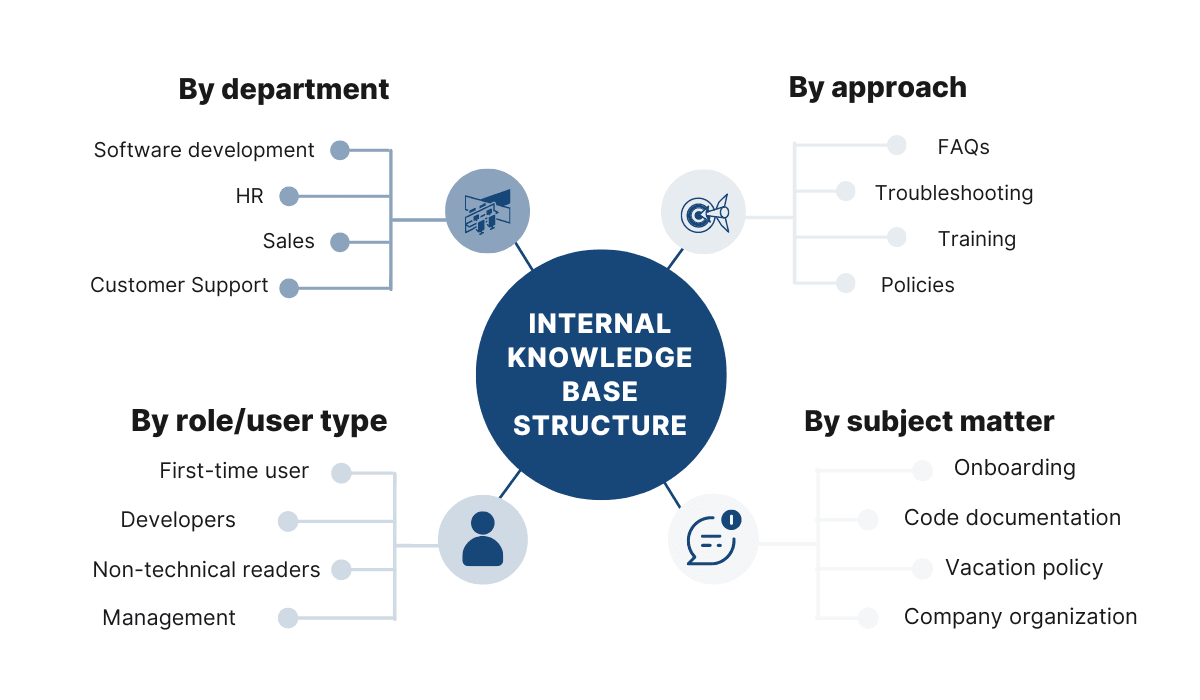
Source: Archbee
Try out some of these categories to structure your internal knowledge base, depending on your existing materials and your organization’s standard operating procedures.
For example, if your developers have a different onboarding process than your designers, it doesn’t make much sense to structure your content based on the subject matter.
Conversely, if all users, technical and non-technical, abide by the same policies, you can structure the knowledge base by approach.
There are no hard-and-fast rules on how to structure your internal knowledge base. Still, whatever method you choose should be logical and work well for your team.
Answer Your Team’s Most Common Questions First
You might not know it, but at any given point, your employees probably lack some information they need to do their work.
For example, although you likely know the code review process by heart, new hires may wonder about it.
The same is true for practices such as requesting vacation or reporting IT problems—these aren’t common, everyday requests, and your team members might not know all the necessary procedures.
In fact, a study recently revealed that a significant amount of time at work is spent just gathering information, especially for highly skilled employees whose work revolves around interacting with others, ranging from doctors and lawyers to managers, customer support personnel and IT professionals.
Take a look:
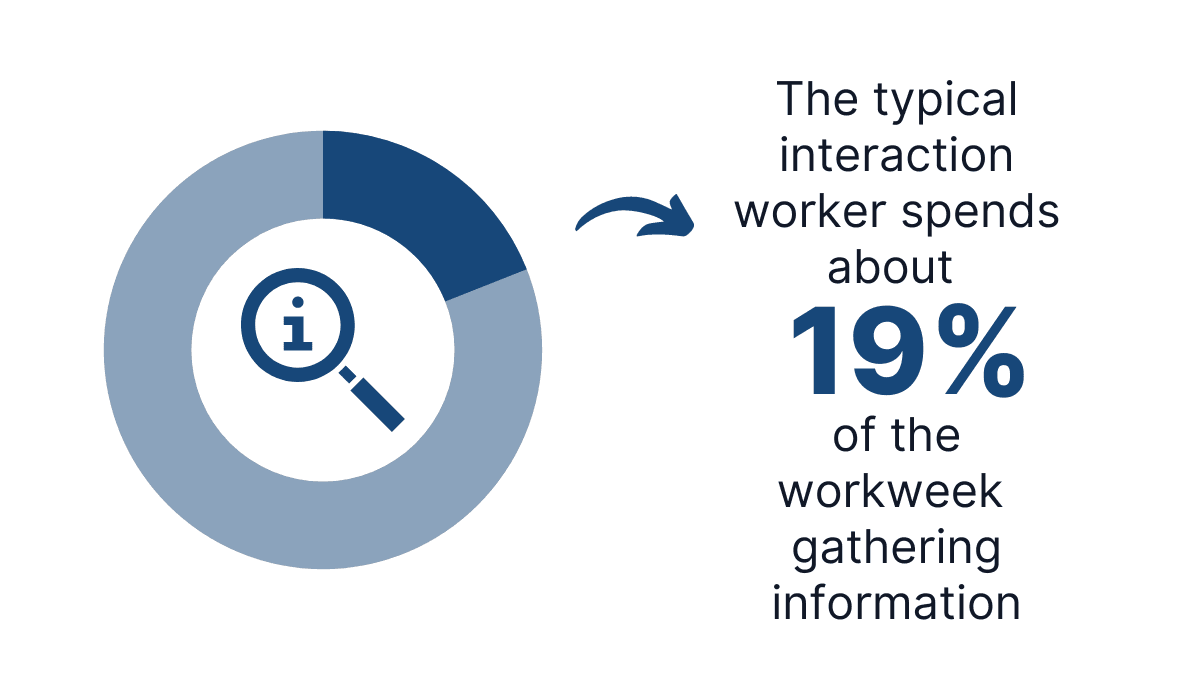
Illustration: Archbee / Source: McKinsey
This is a markedly high number considering the limited number of hours in the week, not to mention all the tasks those employees have to juggle.
So, how to mitigate this issue? How to provide your employees with the essential information they need, whenever they need it?
The easiest method might be just asking them. Or, in the words of Nexthink’s VP of product marketing:

Illustration: Archbee / Source: SHRM
Book off an afternoon, call a team meeting, and pick your employee’s brains about what they struggle with the most.
Determine what they frequently need help with, and use those questions as a starting point for your internal knowledge base content.
With this approach, you can rest assured that the knowledge base is helpful, as you’re not writing articles based on your own judgment.
Instead, you’re going straight to the source and receiving genuine insights; you’re listening to your team members.
Furthermore, it’s also a good idea to specifically question your new hires.
That way, you’ll uncover the most common newcomer pain points and be able to answer them in your knowledge base.
With this approach, you’ll automatically improve your employee onboarding process and facilitate the newcomers’ integration into the company.
For example, did you know the following statistic?
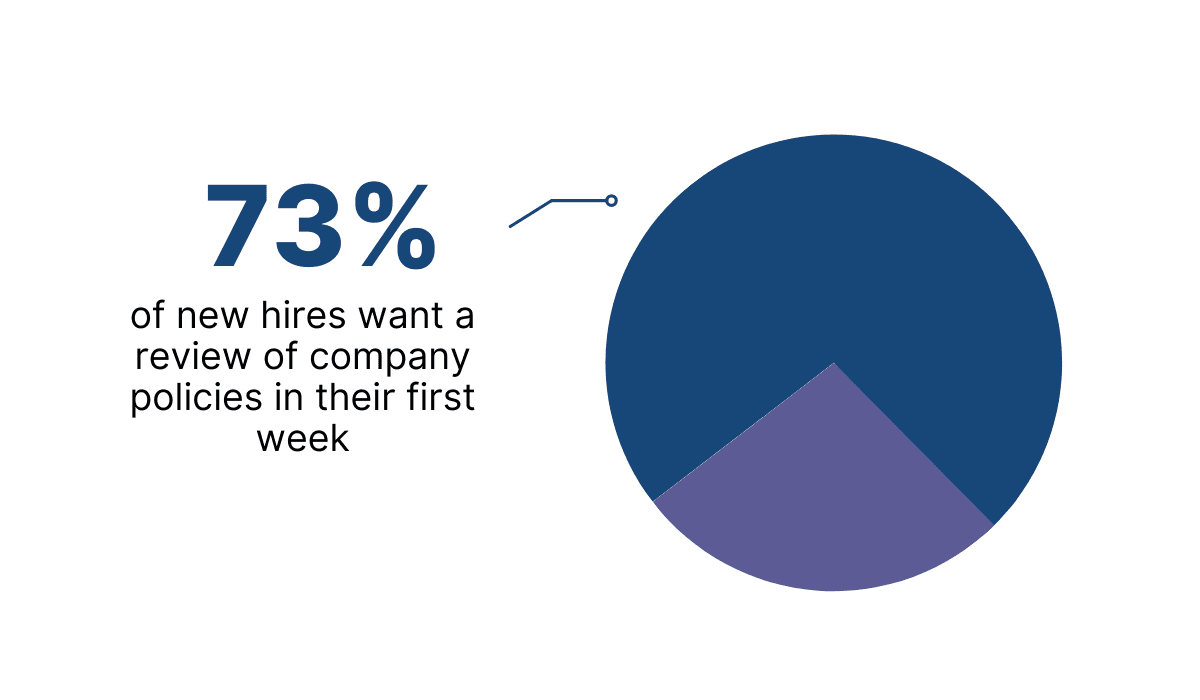
Illustration: Archbee / Source: bambooHR
Given this large majority, your new hires would probably also appreciate a review of company policies soon after joining the company.
Why not address this frequently-asked concern and include company policies in the internal knowledge base?
By uncovering such common questions and providing the answers in your internal knowledge base, you’re sure to facilitate your employees' day-to-day operations.
Encourage Your Team to Contribute
Despite your senior position, there are still some areas where your employees might trump you knowledge-wise.
Let’s say you’ve hired a young QA tester familiar with no-code testing tools—a newish technology you’ve never utilized.
That team member could then educate non-technical employees and expand your testing personnel.
However, this is only possible if the QA tester shares their knowledge; otherwise, you miss out on their expertise.
Studies have proven the significant negative consequences of such knowledge hoarding:
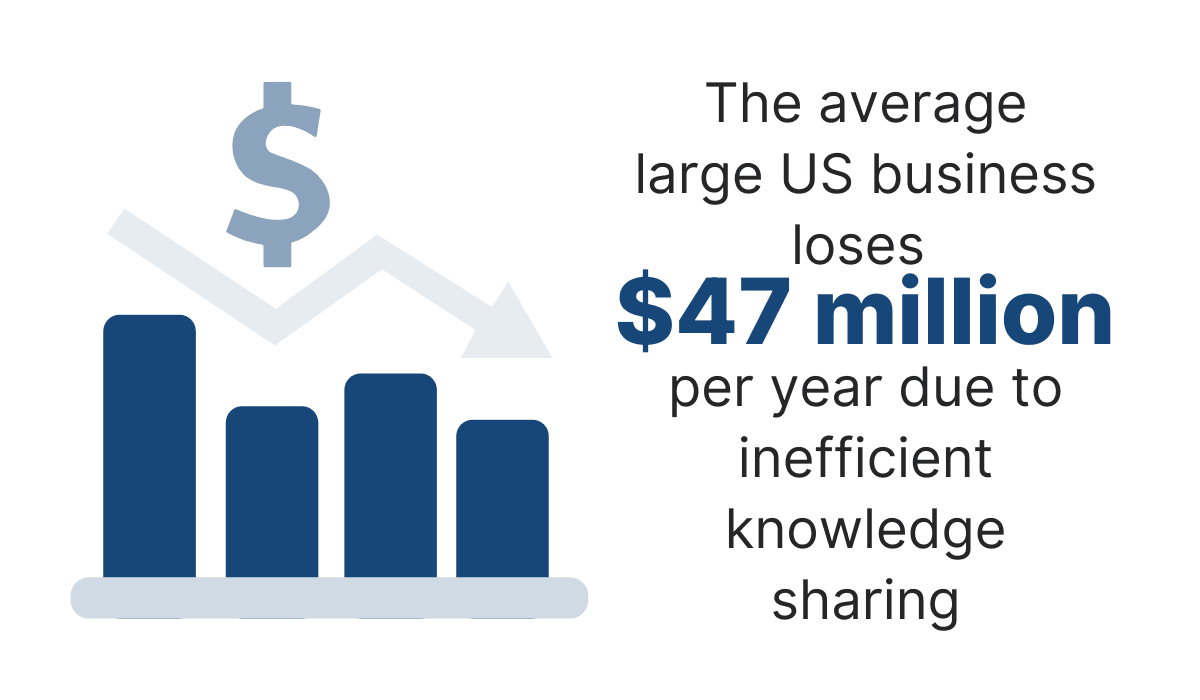
Illustration: Archbee / Source: Panopto
We previously illustrated just one harmful instance of knowledge-hoarding. Imagine if all your employees acted similarly; it’s easy to understand the financial fallout.
To avoid these losses, it’s essential to share knowledge by encouraging employees to contribute to the knowledge base.
Each of them surely possesses unique insights, and your team will grow stronger from sharing such intelligence.
IBM’s second CEO, Thomas J. Watson Jr., championed similar ideas. The industry leader commented the following about his company:
There are a lot of ideas worth listening to in this company. Let’s be sure we’re paying attention. We are never so rich in ideas that we can afford not to.
This principle is applicable beyond IBM.
Sharing ideas and information amongst your team is always a good idea, as everyone can learn from one another.
By distributing such intelligence via your internal knowledge base, they’ll have more resources to perform their jobs well.
When organizing these knowledge base contributions, start by deciding who will perform these roles:
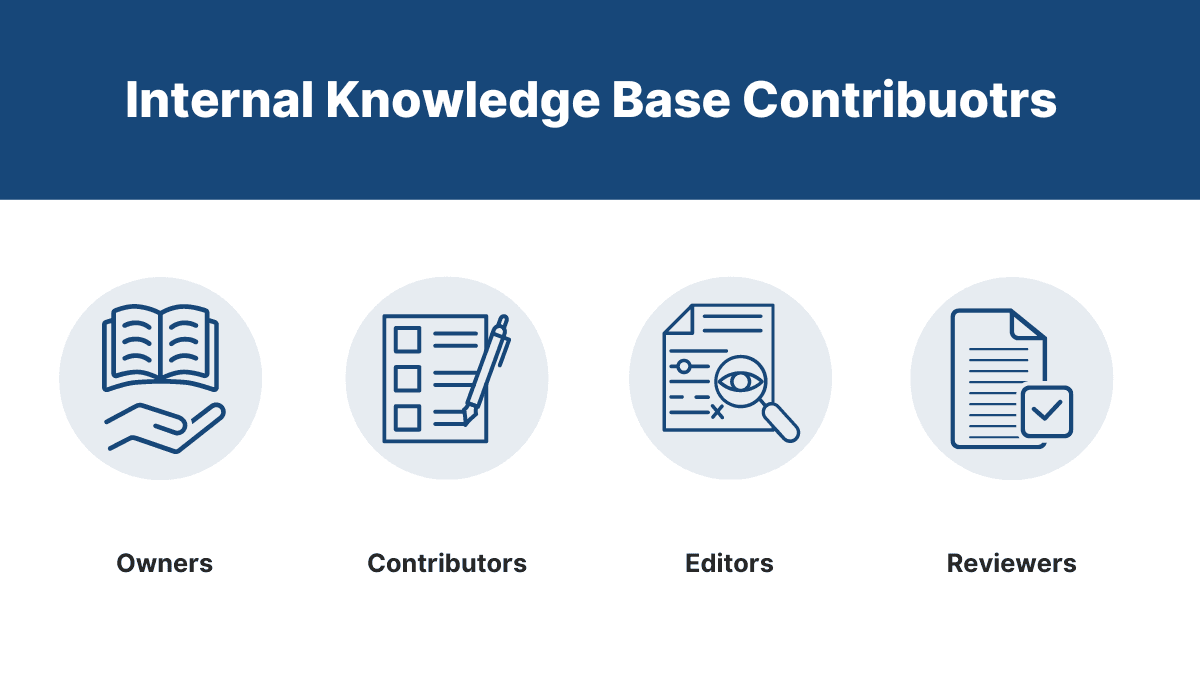
Source: Archbee
First, determine your core knowledge base team—the owners, who maintain, structure, and compose knowledge base content. These should ideally be employees with a knack for writing.
Then, identify occasional contributors and editors. These colleagues should enrich the knowledge base as their other tasks allow.
Finally, also assign article reviewers—someone to verify the information is correct.
To facilitate this setup, it’s worth starting a dedicated Slack channel for your knowledge base.
That way, you’ll have a centralized space where your employees can actively work towards developing the knowledge base.
For example, you might name it as follows:
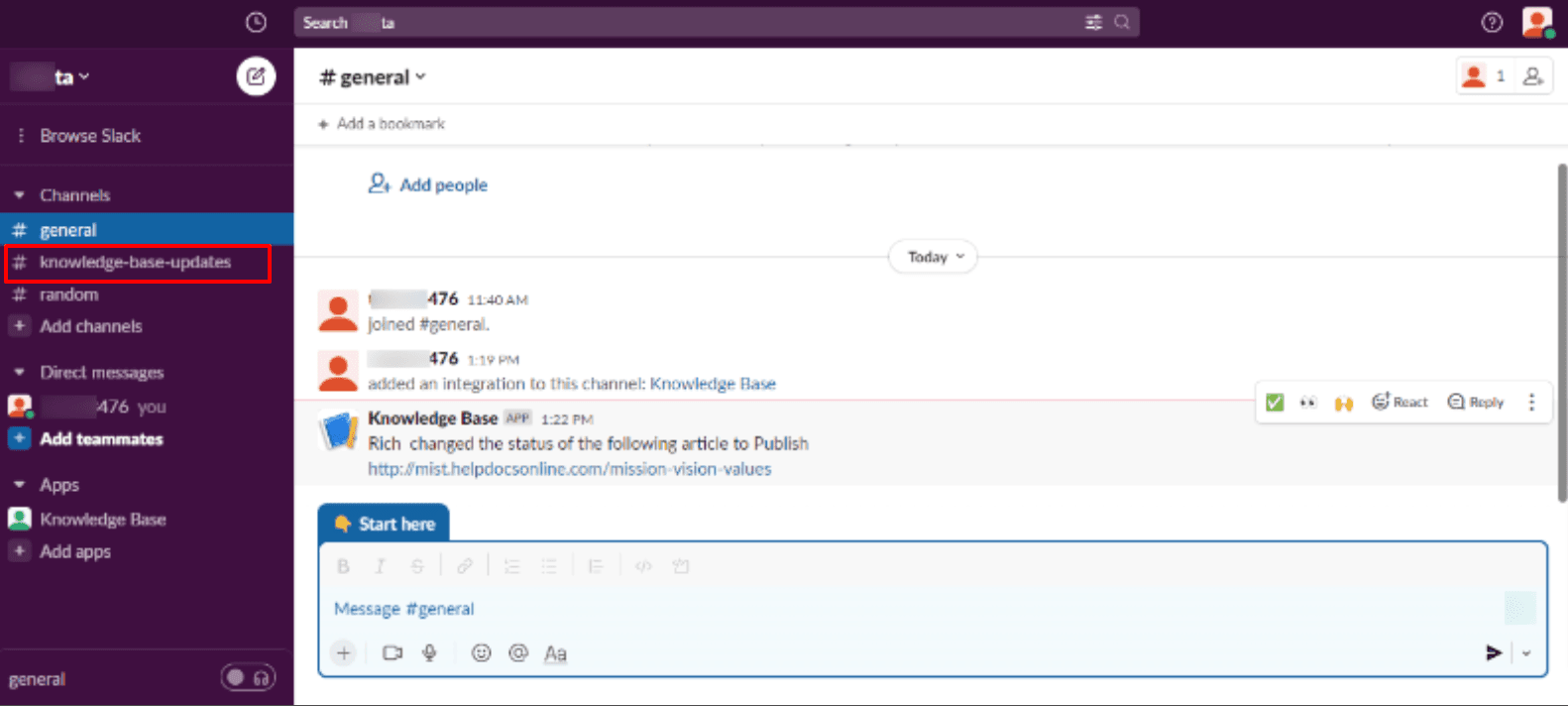
Source: ProProfs
With a dedicated channel for knowledge updates, your organization can brainstorm ideas in one central location and use the space to provide updates and collaborate.
The more team members participate, the higher the quality of your knowledge base. As such, ensure you encourage your team to contribute.
Determine How to Maintain Your Knowledge Base
How many times has your organization’s work-from-home policy changed? Does your referral program function the same as it did when you arrived?
Are you using the same tools from a year ago?
As an organization grows, its processes will fluctuate. Just imagine if an employee requested sick leave in 2023 per 2022 policies.
They’d likely confuse HR and maybe won’t even get their leave approved.
Although this situation sounds absurd, it could happen if you neglect to maintain your internal knowledge base.
As your company’s procedures change, your internal knowledge base must be updated to reflect these changes.
Otherwise, Arne Stamer, founder of My Package Tracking, warns the following might happen:
Over time, the contents of a knowledge base can become outdated or inaccurate. To ensure that a knowledge base remains relevant and useful, it is important to regularly update and revise its contents.
If you never revise your internal knowledge base, the information will likely become inaccurate and, consequently, unhelpful.
To avoid such situations, try to develop a regular review schedule and double-check the content of your knowledge base at regular intervals.
An easy method for this is to utilize Archbee.
This documentation tool offers document verifications—a feature where one colleague is assigned to a specific document and then becomes responsible for ensuring its content is current.
Archbee facilitates this task by sending out recurrent notifications, reminding the owner to double-check the document’s accuracy.
Here’s how the process works:
Source: Archbee on YouTube
With this process, you’ll have a reliable, consistent procedure that facilitates your knowledge base upkeep.
In addition to this feature, it’s also worth implementing functional version control. Unfortunately, employees don’t entirely trust this practice, as a recent survey revealed:
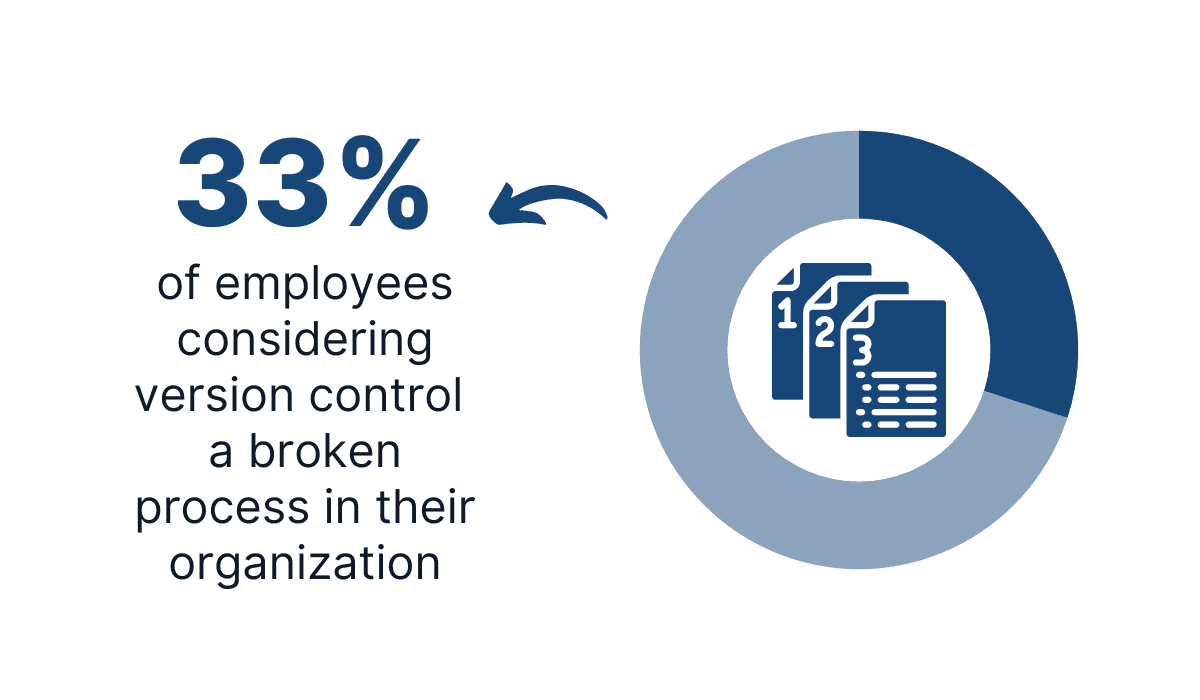
Illustration: Archbee / Source: Nintex
Considering the skepticism, it’s important to ensure that your version control practices meet high standards to incite your employees to start relying on it again.
This feature is hugely helpful, as it indicates which document version is the most recent; your team members can immediately know if they’re looking at the current document version.
Furthermore, the document date should be immediately apparent.
If the article looks pretty outdated, this will raise alarm bells, and your employee will be alerted to double-check the information.
With this feature, maintaining your knowledge base and its content will be greatly facilitated.
Make Improvements With the Help of Analytics
Although you can edit your internal knowledge base based on your own judgment, such changes are subjective.
For example, you might remove an article because you don’t think anyone uses it, only to discover that the customer service team frequently reads it, meaning that what you deemed unnecessary turned out to be highly necessary.
Consequently, acting on your gut instinct is never a good idea.
Instead, it’s usually more productive to utilize analytics, relying on concrete data to make decisions that improve your internal knowledge base.
Laszlo Bock, Google’s former SVP of people operations, agrees. He stated the following:

Illustration: Archbee / Source: officevibe
By extracting exact data points about your internal knowledge base, you’ll have objective, actionable insights you can then leverage for content development ideas.
However, when using such analytics, it’s essential to be proactive.
It’s not enough to start improving the knowledge base when someone mentions incorrect information or when upper management asks for a report.
Instead, data should be regularly collected and continuously consulted to advance the knowledge base whenever the opportunity arises.
With such constant analytics monitoring, you can immediately identify pain points and consistently track both negative and positive trends.
For a better understanding of this proactive data-driven approach, look at the visual below:
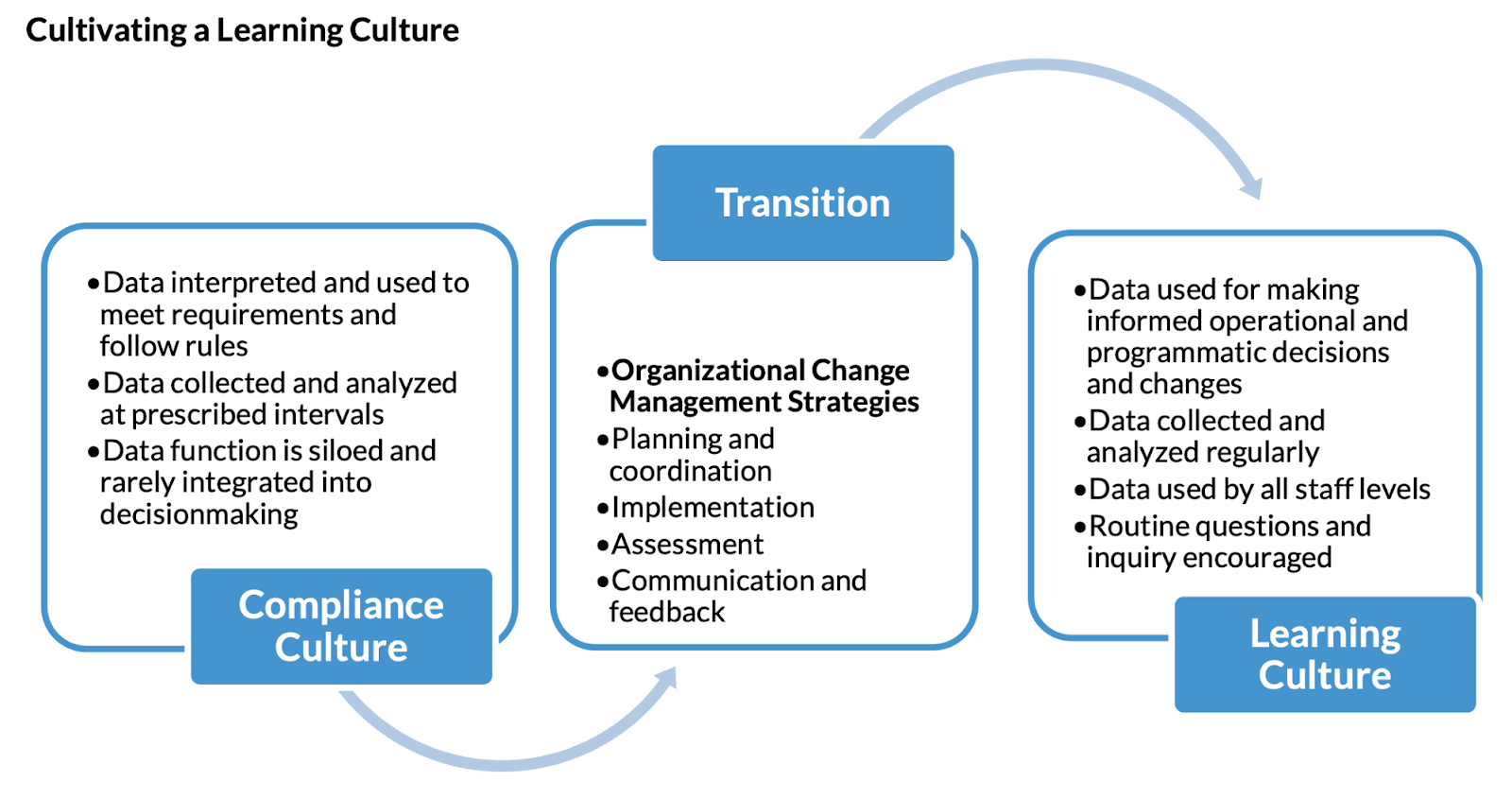
Source: Urban Institute
With proper coordination and communication, you can develop a high-level analytics plan to consistently advance your knowledge base.
There’s no need to wait for an executive’s order or a quarterly report—analytics should be continuously examined as your knowledge base grows.
If you’re not sure what exact metrics to look at in these consultations, try the following:
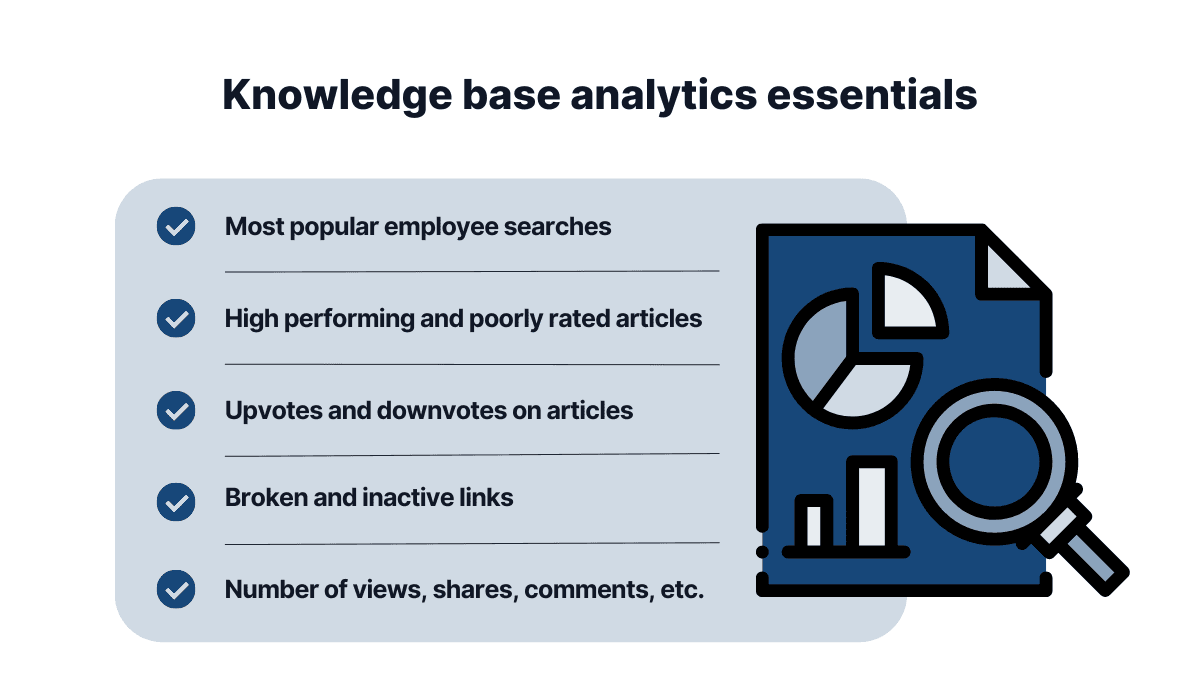
Source: Archbee
By monitoring these metrics, you’ll surely improve your knowledge base.
Removing inactive links will improve the technical side of things, whereas tracking article performance should give you an idea of which content is best received.
Similarly, monitoring searches should indicate what content your employees would appreciate more of, and the number of shares and comments will point to their favorite topics.
With such analytics, you’ll have reliable, helpful insights into your knowledge base’s performance you can then use to improve its content.
Conclusion
With an extensive, high-quality internal knowledge base, you’ll empower your employees to find all the information they need, whenever they need it.
There won’t be any fruitless searching or tracking down colleagues to help; all the necessary intelligence will be collected in one centralized repository.
As a result, your team members will save time and consequently be more efficient in completing their everyday tasks.
Having such resources readily available is a huge help when juggling the workday.
If you haven’t started building your internal knowledge base, think about starting sometime soon—your employees will thank you for it.
Archbee makes it easy and intuitive to start your own knowledge base. Try it yourself with out free trial.
Frequently Asked Questions
An internal knowledge base is your team’s single source of truth. It centralizes policies, processes, how‑tos, templates, and FAQs so people can find accurate answers without chasing coworkers. Key benefits: - Faster answers and fewer interruptions - Consistent, up‑to‑date information across the company - Smoother onboarding for new hires - Reduced errors and compliance risk - Knowledge retention when people switch roles or leave Typical content includes things like requesting time off, filing expenses, reporting IT issues, code review steps, and meeting guidelines—organized and searchable so everyone can self‑serve with confidence.



